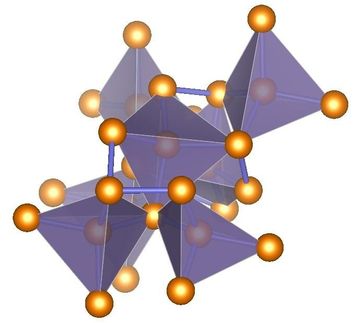Strongly interacting electrons in wacky oxide synchronize to work like the brain
Current computing is based on binary logic - zeroes and ones - also called Boolean computing, but a new type of computing architecture stores information in the frequencies and phases of periodic signals and could work more like the human brain using a fraction of the energy necessary for today's computers, according to a team of engineers.
Vanadium dioxide is called a "wacky oxide" because it transitions from a conducting metal to an insulating semiconductor and vice versa with the addition of a small amount of heat or electrical current. A device created by electrical engineers at Penn State uses a thin film of vanadium oxide on a titanium dioxide substrate to create an oscillating switch.
Using a standard electrical engineering trick, Nikhil Shukla, graduate student in electrical engineering, added a series resistor to the oxide device to stabilize oscillations over billions of cycles. When Shukla added a second similar oscillating system, he discovered that, over time, the two devices began to oscillate in unison. This coupled system could provide the basis for non-Boolean computing. Shukla worked with Suman Datta, professor of electrical engineering, and co-advisor Roman Engel-Herbert, assistant professor of materials science and engineering, Penn State.
"It's called a small-world network," explained Shukla. "You see it in lots of biological systems, such as certain species of fireflies. The males will flash randomly, but then for some unknown reason the flashes synchronize over time."
The brain is also a small-world network of closely clustered nodes that evolved for more efficient information processing.
"Biological synchronization is everywhere," added Datta. "We wanted to use it for a different kind of computing called associative processing, which is an analog rather than digital way to compute."
An array of oscillators can store patterns - for instance, the color of someone's hair, their height and skin texture. If a second area of oscillators has the same pattern, they will begin to synchronize, and the degree of match can be read out.
Datta believes it will take seven to 10 years to scale up from their current network of two-three coupled oscillators to the 100 million or so closely packed oscillators required to make a neuromorphic computer chip. One of the benefits of the novel device is that it will use only about one percent of the energy of digital computing, allowing for new ways to design computers. Much work remains to determine if vanadium dioxide can be integrated into current silicon wafer technology.
Most read news
Topics
Organizations
Other news from the department science

Get the chemical industry in your inbox
From now on, don't miss a thing: Our newsletter for the chemical industry, analytics, lab technology and process engineering brings you up to date every Tuesday and Thursday. The latest industry news, product highlights and innovations - compact and easy to understand in your inbox. Researched by us so you don't have to.



























































